In terms of social, it seems that many SharePoint 2010 customers wanted and/or continue to want a little bit more than “out-of-the-box”. This is especially the case for clients who use the activity feed – one of the features which changed SharePoint to be more of a social platform. “How do I reply/comment on one of these things in my activity feed?” clients usually say. “Where’s the ‘like’ button?!”. And so, a whole host of 3rd party products sprang up – some dedicated to SharePoint (Newsgator, Beezy, SnapworkSocial etc.), some more generic and sometimes cloud-based but with SharePoint integration (Yammer etc.). I’m not an expert in those products, though I have looked at some. What I do know is that most are still evolving, and if you started this journey a while ago, frankly you might not have liked any of them. Maybe you have reasons for still not liking any of them, such as privacy concerns. Or perhaps the fact that many want to be a parallel universe alongside SharePoint, where content is “sync’d” or “published” to. Something I notice about several products is that they completely replace the SharePoint activity feed, and so many of the good things about what Microsoft built are unfortunately lost - notifications around tags I’m interested in, job title changes, someone specifying they have the same interest as me, and so on. These are all valuable features which I’ve seen work well in the enterprise – they help connect people, content and company projects/workstreams which are relevant to each other.
Here I want to show you what we did for one client, perhaps taking a more SharePoint-centric route. I’m not here to sell it (it’s not a shrink-wrapped product, and I don’t own it), but I thought it would be fun to talk about some of the pinch points in SharePoint, and what you might do about them. I won’t be publishing source code. This was part of a project I worked on for Content and Code, a partner in the UK. I worked as part of a small but talented team, consisting of myself, Wes Hackett and Rich Browne (Rich is an extremely capable ‘under the radar’ kinda guy). Some of the client’s offshore team (a great group) also worked on other functionality around this set.
The activity feed – from “one way” to “two way”
So let’s start with the activity feed. Let’s go from this:
..to this (click to see larger image):
Notice that the content is pretty much the same in both images. The look and feel is clearly stolen from influenced by Facebook, but I’d like to think there’s more to it than that. Obviously we have the big ‘tick-list’ items such as liking and commenting (more on these later), but we also enhanced some other aspects of the SharePoint 2010 activity feed too:
- Activity feed items related to SharePoint content – did it ever strike you as weird that SharePoint is an ECM system, but only status updates, job title changes and other ‘social’ things appear in the activity feed? Our client thought so, and we changed that. Our feed has the following content:
- Announcements, discussions/discussion replies, wiki pages/enterprise wiki pages, blog posts and blog comments. Notice that documents are missing – obviously most SharePoint environments have huge volumes of documents, so this content type requires some thought. Later I’ll talk about our ‘subscriptions’ framework which gives a user the option of seeing documents for certain locations.
- [Side note: the ECM content types appear in the first image above too, but only because our ‘activity publish’ code is working with the OOTB ‘presentation’ code – they wouldn’t show in a standard SP2010 installation.]
- [Side note: my buddy Wes has the best reference on the internet on how to do this, including some code samples – see Extending the activity feed with enterprise content]
- Richer activities:
- The blog article in the images above is a great example – in the OOTB activity feed, users can only see the article title. In our version, you see the title and the first bit of the content - providing more context to help you decide whether the link is worth following.
- Also check out the ‘Rich Browne added a new colleague item’ item. If he’s added a new colleague, it might be nice to show a picture of him.
- Iconography – this makes it easier to quickly identify what an entry is about.
- ‘Likes’ in the feed - under certain circumstances, ‘likes’ are published to the feed as an activity. See the first item in the second screenshot). More on this later.
- ‘My activity’ view – this helps me find things I’ve published. For example, if I uploaded a PowerPoint presentation recently and know someone made an interesting comment, this view will help me find it again.
- Status update bar – no longer any need to navigate off to my SharePoint profile page just to update my status.
- Look and feel – subjective, but arguably prettier :)
Commenting/note board
Dialogue and conversation is the backbone of most social solutions, and no doubt you’re familiar with how it works on Facebook et al. But SharePoint 2010 already has the note board which allows comments/notes to be added on every document, page and list item – so isn’t that enough? Well, possibly not. For one thing, consider that we want to be able to comment on ‘social’ activities such as status updates, job title changes and so on. On a different tangent, the SharePoint 2010 note board architecture is effectively incompatible with a Facebook-style display of activities and comments hanging off them (as shown in our enhanced activity feed). This is because to fetch the set of comments for a feed containing 20 items, I have to make 20 individual calls to SocialCommentManager.GetComments() – which is clearly not going to perform or scale. So, we need a different approach.
In our case, we took the big decision of scrapping the standard note board. Some big considerations here include the migration path to vNext, but we concluded that to write some migration scripts (and migrate the volume of data we would have) would be completely in-line with the expectations of an upgrade project. So without the shackles of the OOTB design, it’s possible to go back to first principles and use whatever data schema fits best. The key is simply being able to retrieve all your likes/comments (and anything else) in one operation, for whatever page/web part designs you come up with. Nothing more to it. When implemented this way, it means that a user can add a comment to a SharePoint item either from the activity feed OR from the item’s note board, and such comments would show wherever I looked at the item. Notably, the way most ( maybe all?) 3rd party products deal with this is to side-step the issue completely – comments in the activity feed only show in the activity feed, and notes on the note board purely live on the note board – and never the twain shall meet. Our client wasn’t comfortable with this due to the huge overlap between the two concepts - the feeling was this disjointed behaviour could be confusing to users. We debated that our path could mean that some “noise” comments would be stored against items (“Dude, nice kitten photo LOL!”), but our client preferred this to the alternative.
So whilst we’re having to do work around the note board, we may as well give it some UI love. Rich, my partner in crime, decided that the native “show 5 items and do paging” approach was pretty poor in this enlightened age of Facebook infinite scrolling. Even weirder, did you notice that any user can delete another user’s note? Governance, who needs it?! Here’s a reminder of the out-of-the-box note board:
Here’s what we ended up with:
If I’d been logged in as one of the users above, then of course ‘Edit’ and ‘Delete’ links would show next to my notes as appropriate (i.e. we fixed the lack of security around ‘Delete’). Notice also that our dates are a bit more user-friendly than SharePoint’s ‘raw’ display of a date/time.
Note board web part
Consider also that in addition to the ‘tags and notes’ window, the SharePoint note board is also a web part which can be dropped on a page. This can be a great idea for a team site home page for example, so we ensured our note board had the same capability:
Profile note board
In SharePoint 2010, the note board also appears on a user’s profile page and can be used to leave a note for that person. In that context, it looks like this:
This is definitely a useful piece in the social feature set - people are certainly getting used to sending messages using something other than e-mail. However, the lack of ‘reply’/threaded discussions frequently becomes an issue – you end up with the ridiculously disjointed situation of writing on each other’s profile in order to have a conversation. We thought it should be something more like this:
If you ever want to do something similar, don’t forget the e-mail notifications which alert a user that a note has been left on their note board. Of course if you are doing something custom, you’ll have the opportunity to enhance the e-mail content and behaviour – for instance, not only sending a notification when someone posts on your note board, but also when someone replies to a conversation you’re involved in.
Entry points
So it’s great that we have this super-duper note board, but it’s also worth mentioning the experience to get to it. Since we already had much of the back-end code to support it, we thought we may as well display the number of likes/comments for the current page (or highlighted list item, or whatever). This is great for instantly seeing “interaction” around the current item, and probably encourages people to perform these social actions:
These are basically direct replacements for the social controls added to the ribbon for ‘I like it’ and opening the tags and notes window.
Speaking of the ‘I like it’ functionality in SharePoint, let’s talk about how we deal with ‘likes’.
Likes – more important than you might think
SharePoint 2010’s ‘I like it’ is implemented as a social tag – this enables Microsoft to re-use the plumbing for that feature, and in some ways is a nice way of doing things. However, we had a different vision. For us/our client, the main point of liking was to “generate footfall” – in other words, to put content under the eyes of people who would not otherwise see it. Facebook does this. So if a colleague of mine “likes” some content which I haven’t seen in my activity feed because it was created by a non-colleague or in a site/list/library which I don’t have a ‘subscription’ to (N.B. ‘subscriptions’ are another custom piece, which I’ll talk about later), then I’ll see it in my feed:
So in the image above, Tristan Watkins is my colleague but David Bowman is not. We tossed around several ideas for ensuring a good signal-to-noise ratio here. You could definitely get quite sophisticated in terms of “keeping score” of which users have received likes for which content, and such conversations were a good reminder of the complex algorithms behind Facebook. However, simply ensuring I don’t see likes for content I’m already probably aware of was a good starting point. Remember that if the original activity (e.g. status update/document/whatever) appeared in my feed, then I’ll be able to see likes/comments “hanging off” it right there – but it’s the likes “broadcast” activities we need to be careful with. In the end, our implementation of comments also used the same “broadcast” logic – so I could see comments my colleagues were making on items I might not have seen.
The end result is pretty powerful. Our client had some examples across the business where liking brought people together (e.g. they went on to work together on some initiative which was a success for the company) – if you’re cynical about social, seeing this happen might change your mind.
In user-experience terms, of course we also need to be able to see who liked any particular item. We put that as a new tab in the existing ‘tags and notes’ window. Although not shown in this image, I would see ‘Add as colleague’ buttons (and presence icons) next to any people who I wasn’t already colleagues with, since we want to encourage connections across the business:
Subscriptions
If you’re familiar with the social aspects of SharePoint, you’ll know it’s all about colleague relationships. My activity feed gives me a view of what my colleagues are doing and helps me stay in touch. However, in the environment we were working in, this was considered a little “one-dimensional” - colleague relationships aren’t always ideal. What happens, for example, if I discover a great team site where the content is extremely interesting to my work. Let’s say it’s another part of the business working on SharePoint, and let’s say these guys are producing some great architecture documents. I probably don’t want to add all of the contributors to that site as colleagues – for one thing, I may not particularly want their status updates, birthdays, manager changes and so on. I probably do care if they tag documents with ‘SharePoint’ or related terms, but remember that in the out-of-the-box activity feed I can be notified of that simply by ‘following’‘ those tags. So what I really want is just to be notified if new content is created in the site. I guess I could use alerts, but frankly my inbox is busy enough and anyway, surely this is exactly the kind of stuff I occasionally dip into my activity feed for?
So, we created a subscriptions framework. If a user sees some content in SharePoint, they can use it to be notified in their activity feed about new items, without requiring colleague relationships. Users can subscribe at the site (web) level:
..or they can subscribe to a particular list or library:
It’s also possible to subscribe to a site but exclude a “noisy” list or library. Once I have a subscription, I’ll see new content appear in my activity feed, and this includes documents. As I said earlier, we didn’t implement notifications for documents from colleagues because we felt that would result in noise, simply because documents are so prevalent. With subscriptions, it felt like the user would have more control. The image below shows a document in my activity feed – consider also that we now have multiple ways of things coming into my feed, so we added a context menu so that a user can understand why they were seeing a particular item:
Group activity feed
In addition to the main enhancements to the activity feed, we also developed a team/group activity feed. We found this was a great web part to have on a team site home page – visitors to the site could then instantly see new content and other recent activity related to the site. This is a slightly tricky concept to implement with what SharePoint provides, but we were happy with our final design. In our model, this view shows recent activity by any of the owners/members of the site which is relevant to the site, and also any new content, including documents (i.e. as though you had a subscription to the site).
Summary
With SharePoint 2010, the direction of the product moved firmly towards the social arena – of course, the flexibility is there for organisations to opt-in to using this capability or not. However, amongst adopters it’s fairly common to want more than is provided out-of-the-box, and I’ve hopefully given some food for thought on what an enhanced version might look like.
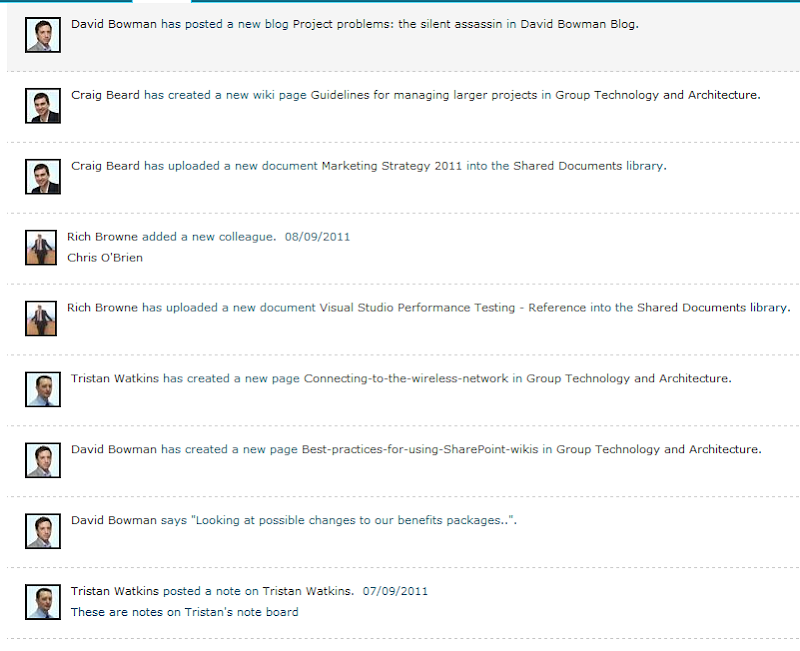
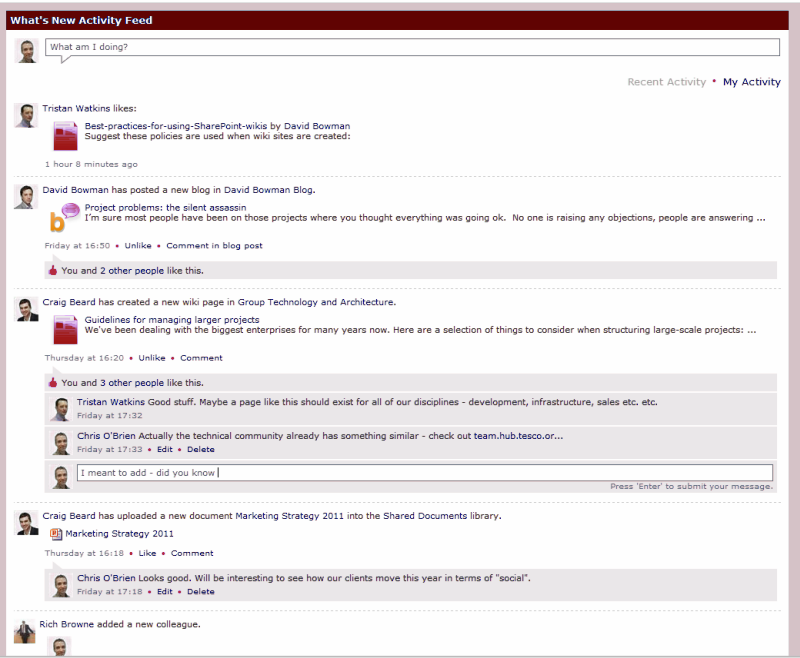
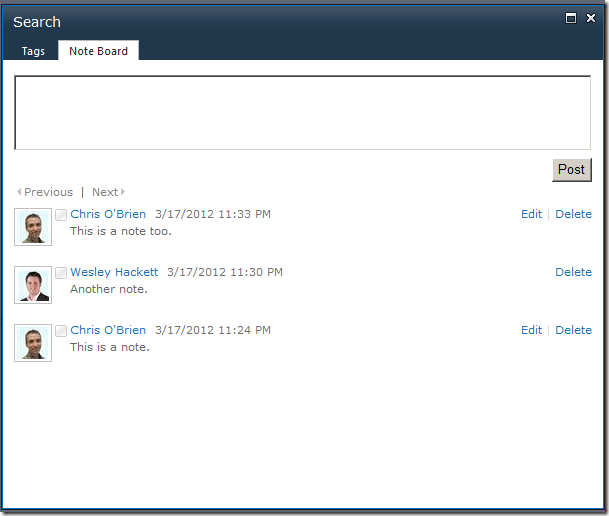
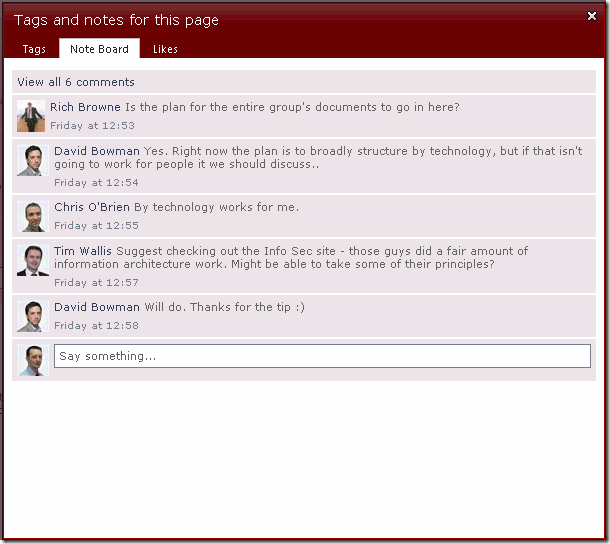
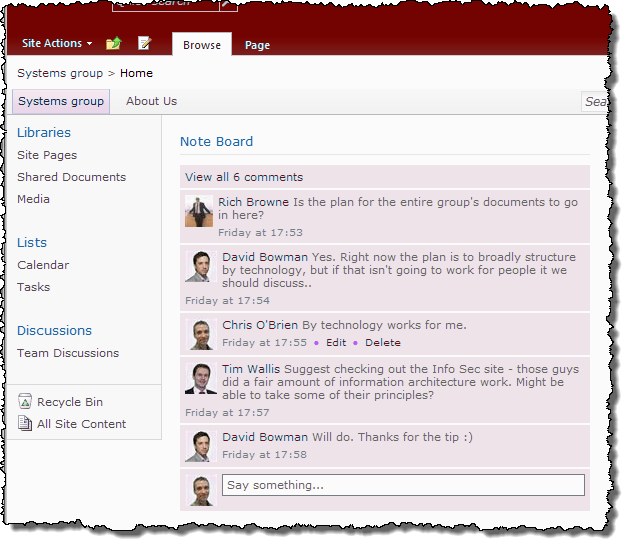
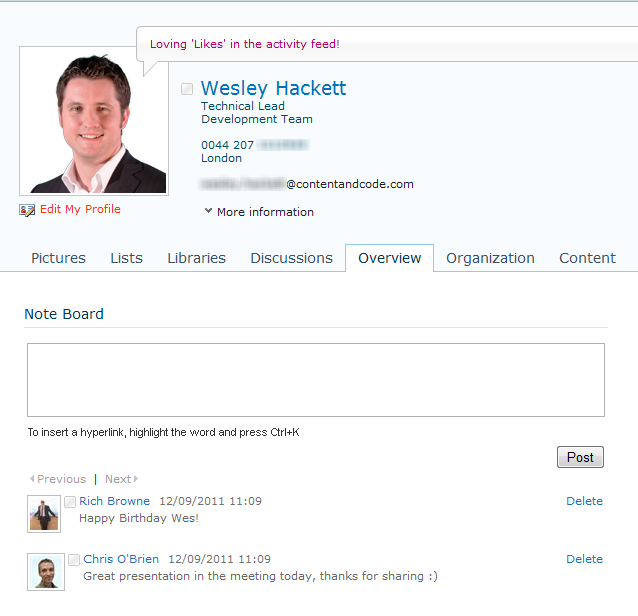
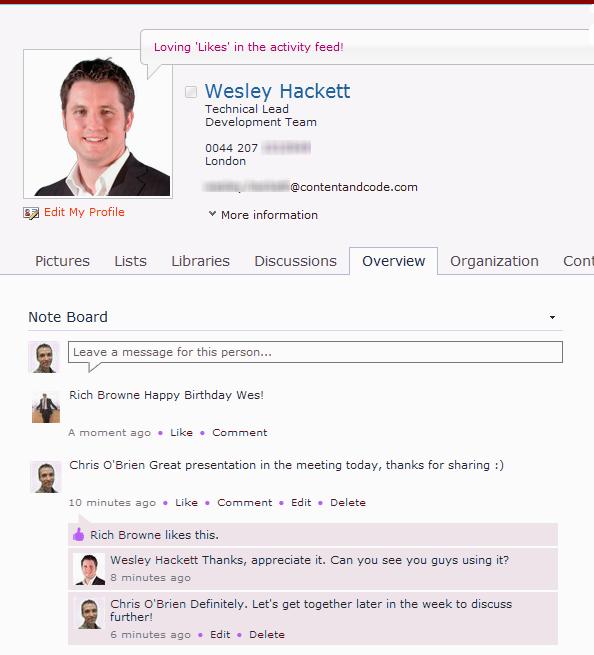


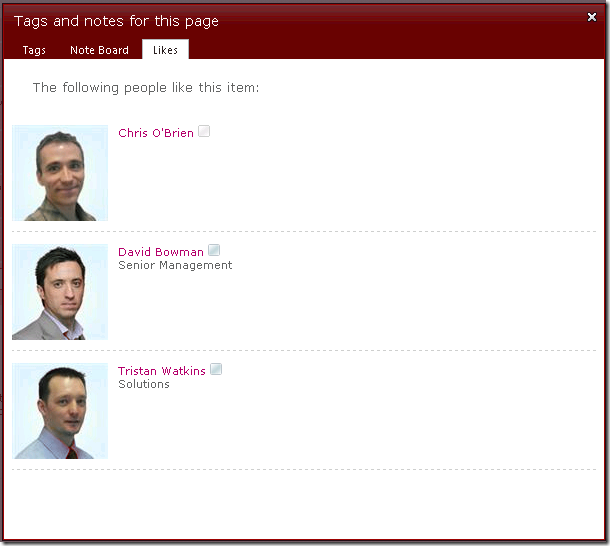
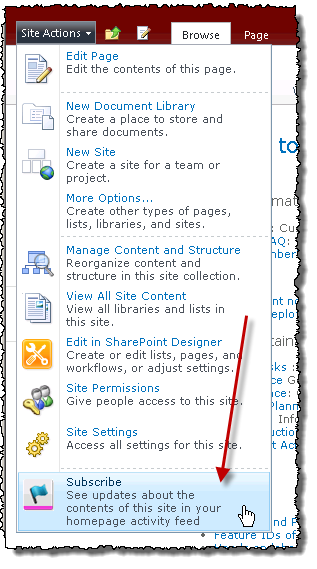
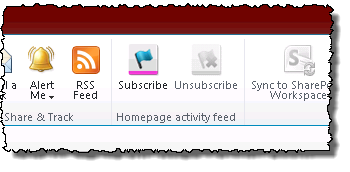




18 comments:
This is absolutely brilliant stuff and shows how, with a little thought, you can plug the missing gaps from the offering that MS had put together.
Thanks for sharing this Chris, it has certainly given me some insperation on improving the social features within our deployment :)
Rich
Awesome demo! The screenshots above look amazing. Thanks for the detailed post and sharing this with the community.
that's very great UI and functionalities. Just see images and imaging about the good product. It's awsome!
Hey Chris,
As usual, great stuff or should I say even better than usual :). I've worked a bit with the Activity Feeds and that's not the easiest API so congrats for these great stuff.
Stephane Eyskens
Great article, Chris!
I saw some bits of this on your session last year BPC in London, and was very impressed.
I see a lot of your features as well in NewsGator Social Sites for SharePoint, but this is a much more complex solution (and quite expensive).
Do you plan to release / sell to the market any of this?
Thanks again!
@Frank,
Thanks for the kind words. I don't personally own any of the code, but you could speak to Content and Code.
Cheers,
Chris.
Thanks!
I've sent them an email now. :-)
Hey Chris,
great post! Thank you for sharing this.
Can you give a hint how long did you need to develop this and how big was the team?
Thank you
Martin
Hey Chris,
great post! Thank you for sharing this.
Can you give a hint how long did you need to develop this and how big was the team?
Thank you
Martin
So, you were able to do this witohut creating your own data structures in SQL server? This has been the big sticking point for me at the beginning stages of a similar project. I have re-orged the social UI and now am looking at the social feeds but woudl prefer not to create my own databases and all of the headaches that it creates administratively and for upgrade considerations. Thanks for the article. very interesting
Wow! what great article, Good work you are the Man. Thank you for sharing this.
This is extremely impressive. It would be nice if the organization that owns the code either sells it or open sources it because my organization would benefit greatly from this!
(open source would be awesome because we are a cash-strapped inner-city school district)
Impressive indeed.
But how did you manage to link comments to OOTB ActivityEvents ?
I've tried but I can't find a way to identify consolidated ActivityEvents created by Sharepoint.
Thank you
@Guillaume,
Yes, we spent a happy morning pondering that one. In our case, the answer was that although ActivityEvents have an ID system in SharePoint 2010, no-one says you have to use it to link to your custom data :) We just used a composite ID (on a scheme that worked for us), nothing more.
Thanks,
Chris.
@Chris
I must have missed something.
Considering that when an event occurs, Sharepoint creates a different ActivityEvent (with different ID) for each person who will see that on his activity feed.
How can you identify all these ActivityEvent tied to the same event, so they can share the same set of comments ?
I did not find any common ID.
The best I could thought is using a combination of CreationDate, publisherID, activityType, etc.
@Guillaume,
I don't remember the exact scheme we used, but it was very similar to what you describe. It worked absolutely fine :)
Thanks,
Chris.
Hi Chris, can you give us an approximate estimate of how much time/effort/money this cost?
I've been working on a custom "Facebook" application based on SharePoint 2010. The base of all magic solution is SocialComment. You can create SocialComments with a custom URI. This is the principal issue. You can create URI's to your Users (UserProfile's) using AccountName as a ID and groups (OrganizationProfiles) using recordId. This seem's simple but it isn't believe me. There are two principal problems. 1) Security, because you'll have to force user that create comments to be as the author of that comment. 2) API of SocialCommentMmanager is A LOT LIMITED. You cannot obtain a SocialComment by ID for example! Your'll have to use "Reflection" ;-) to do some operations. But at the end, and lots of effort we have a custom solution like yours based on SocialComments.
Post a Comment